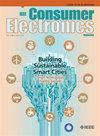Lightweight Convolutional Neural Network-Based Computer Vision Model for Human Behavior Analysis on Consumer Internet of Things Devices
IF 10.9
2区 计算机科学
Q1 ENGINEERING, ELECTRICAL & ELECTRONIC
引用次数: 0
Abstract
The rapid advancements of technology have encouraged the growth of the Internet of Things (IoT), which has transformed how individuals interact with their environments. Among its many branches, Consumer IoT (CIoT) has emerged as a leading force by integrating IoT elements into everyday devices, enhancing user experiences, and offering intelligent services. In particular, smart home environments powered by CIoT devices are improving the quality of life, specifically for the elderly and individuals with disabilities, through automation and behaviour monitoring. To efficiently analyze human behaviour in such settings, this study proposes a novel lightweight computer vision technique, LCNNCV-HBA (Lightweight Convolutional Neural Network-Based Computer Vision for Human Behavior Analysis), specifically optimized for resource-constrained CIoT devices. The proposed method begins with Median Filtering (MF) to eliminate noise, followed by ConvNeXtTiny, a compact yet effective deep learning architecture used for feature extraction by capturing key spatial patterns from images with minimal resource consumption. For behaviour classification, a stacked denoising autoencoder (SDAE) is employed, while an Improved Sparrow Search Algorithm (ISSA) is used to fine-tune hyperparameters and enhance model performance. Experimental validation conducted on a benchmark image dataset demonstrates the effectiveness of the proposed LCNNCV-HBA approach, achieving a superior accuracy of 98.56%, outperforming existing methods in both efficiency and precision.基于轻量级卷积神经网络的消费类物联网设备人类行为分析计算机视觉模型
技术的快速进步促进了物联网(IoT)的发展,它改变了个人与环境的互动方式。在其众多分支中,消费物联网(CIoT)通过将物联网元素集成到日常设备中,增强用户体验并提供智能服务,已成为主导力量。特别是,由物联网设备驱动的智能家居环境正在通过自动化和行为监控改善生活质量,特别是老年人和残疾人。为了有效地分析这种环境下的人类行为,本研究提出了一种新的轻量级计算机视觉技术,LCNNCV-HBA(基于轻量级卷积神经网络的人类行为分析计算机视觉),专门针对资源受限的CIoT设备进行了优化。所提出的方法首先使用中值滤波(MF)来消除噪声,然后是ConvNeXtTiny,这是一种紧凑而有效的深度学习架构,用于通过以最小的资源消耗从图像中捕获关键空间模式来提取特征。在行为分类方面,采用层叠去噪自编码器(SDAE),改进的麻雀搜索算法(ISSA)对超参数进行微调,提高模型性能。在一个基准图像数据集上进行的实验验证证明了LCNNCV-HBA方法的有效性,准确率达到了98.56%,在效率和精度上都优于现有方法。
本文章由计算机程序翻译,如有差异,请以英文原文为准。
求助全文
约1分钟内获得全文
求助全文
来源期刊
CiteScore
7.70
自引率
9.30%
发文量
59
审稿时长
3.3 months
期刊介绍:
The main focus for the IEEE Transactions on Consumer Electronics is the engineering and research aspects of the theory, design, construction, manufacture or end use of mass market electronics, systems, software and services for consumers.

 求助内容:
求助内容: 应助结果提醒方式:
应助结果提醒方式:


